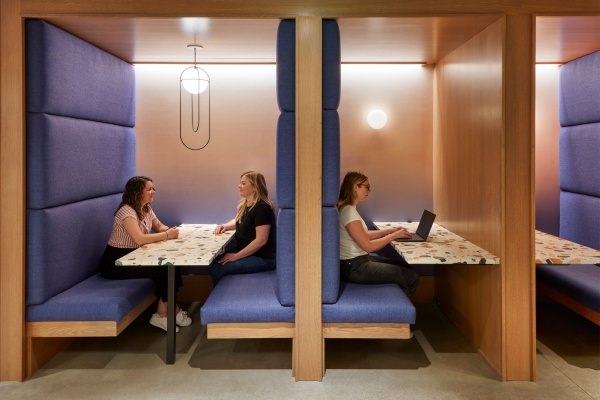Your Perfect Office Space – 50% Off Your First 3 Months! Learn More
Carr Workplaces
Use Flexible Work Options To Attract and Retain Top Female Talent
Jan 5th, 2024 
A diverse workforce has been shown to foster greater creativity and innovation across industries.
Multiple studies also have found that having more women in the workforce generally makes a company a better place to work for all and even could raise a country’s GDP by as much as 10 percent.
Albeit temporarily, the recent COVID-19 pandemic caused a significant number of women to leave the workforce, as they were faced with additional care responsibilities at home.
Though women’s employment levels are now back to pre-pandemic levels, the pandemic illustrated how vital it is for women to actively participate in the workforce.
As a business, one of the best ways to retain female talent and attract top female candidates — regardless of what is happening at a broader economic level — is to offer flexible work options.
As Martine Ferland writes for Fast Company, “Flexible work can create a level playing field for people who carry greater care obligations at home.”

What Is Flexible Work?
Flexible work options not only can help you attract and retain top-notch female talent. It also can help you retain and motivate seasoned employees of all genders, increase diversity and inclusion, reduce absenteeism, increase productivity, and lower overhead costs.
Flexible work arrangements can include any type of schedule or workplace environment that isn’t the typical 9-5 schedule in the office.
Check out these five common types of flexible work options:
-
Flex Time/Flex Schedule
When an employee works a flex schedule, they have flexibility around their workday start and end times. This allows employees to customize their work schedules around their responsibilities at home.
-
Telecommuting
Also sometimes referred to as flex place, telecommuting or teleworking allows employees to work remotely from home or another location.
-
Hybrid Work
Hybrid work entails giving your employees the ability to split their time between working in an office and working remotely from home or another location.
-
Compressed Work Week
A condensed or compressed work weeks allows employees to work their required number of hours in less than five days. The employee may start and/or end their days earlier or later to reduce the number of days they must work.
-
Job Sharing
With job sharing, two or more employees split up one full-time position and the work hours associated with the job. With a job share, employees may alternate days or work a split schedule.

How Flexible Work Options Help Women Balance Home and Work Life
The reality is that women often face inequality both at work and in their lives at home when it comes to domestic responsibilities.
In the United States, women still do almost twice as much unpaid care work as men. Even when women are the “breadwinners” in the family — earning the majority of their household income — they still do all or most household work, as well.
Flexible work options like hybrid work, telecommuting, and the other options discussed above allow women to better balance their professional and personal lives.
If your female employee needs to be home when her children get off the bus or to care for an aging parent, a hybrid schedule could be the difference-maker when it comes to whether she stays with your company or looks elsewhere.
Don’t believe us? A survey conducted this year found that nearly 75% of women would look for a new job if their employer took away hybrid work options.
In today’s very competitive labor market, you would be wise to offer hybrid work and other flexible work options to all employees and candidates, but particularly to female employees and candidates.
Hybrid work can serve as an equalizer in the workplace as well, increasing gender equality within your company. Increasing gender equity is shown to increase profitability by as much as 63%.
The flexibility of hybrid work also allows women to take better care of their mental and physical health. Multiple studies find that good employee mental and physical health are correlated with greater productivity and higher employee retention.

Why the Recent Expiration of Federal Emergency Child Care Funding Should Be on Your Radar
While women have largely returned to the workforce since the COVID-19 pandemic began, the additional care-taking responsibilities women hold outside of work will continue to impact their participation in the workforce.
Last year, American Rescue Plan funding for child care centers expired, affecting more than 220,000 child care centers across the country. It’s estimated that this funding loss could result in the closure of as many as 70,000 childcare centers across the United States.
Although a federal bill, The Child Care Stabilization Act, was introduced this month to restore federal funding to the 220,000 childcare providers, it has yet to be passed by Congress. If this child care funding cliff remains, it could have a considerable impact on female participation in the workforce yet again, which would have a devasting impact on hiring and the broader U.S. economy.
That’s why it’s essential for employers to consider flexible work options for all employees, but especially for female employees. Doing so can help mitigate another COVID-19-like scenario in which female workers must leave the workforce or reduce their hours in order to care for children or others at home.
Schedule A Tour Of A Carr Workplaces Location or call us at (866) 982-5803 to learn more about our flexible work options, including private offices, team spaces, and coworking spaces.
Discover “5 Ways AI Can Help Your Business: Artificial Intelligence As A Helper, Not A Hinderer.”